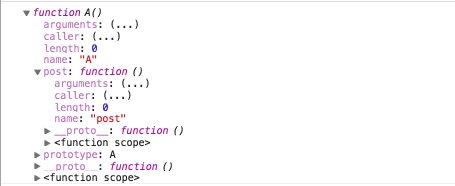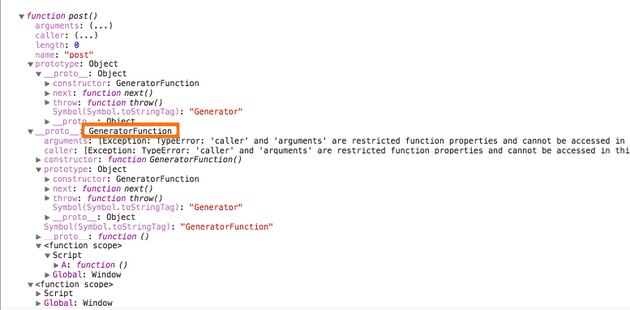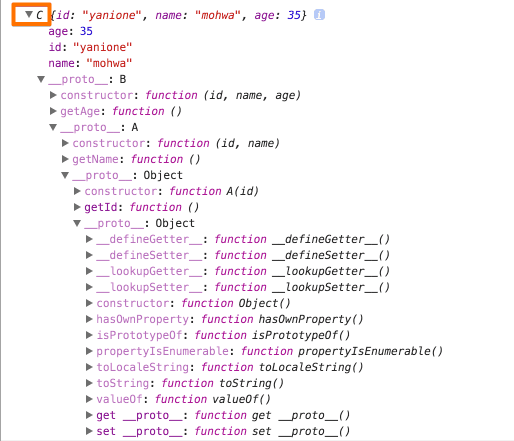1. 글에 대해
-
이 글은 Hika Maeng 님이 추천해주신 ECMAScript 6 길들이기라는 책과 개인적인 테스트를 통해 작성되었습니다.
-
또한 모든 결과는 Chrome 브라우저를 통해 테스트된 결과입니다.
2. 클래스 선언 및 표현식
-
ES6 클래스는 ES5 가 가진 객체 지향 모델을 좀더 명시적으로 다룰수 있도록 개선된 새로운 모델이다.
-
클래스 선언식
// 클래스 선언 class A { constructor(id){ console.log(arguments); // ['yanione'] try{ console.log(arguments.callee); } catch(e){ // ES6 클래스 body 는 기본적으로 strict mode 위에서 동작한다. // 'caller', 'callee', and 'arguments' properties may not be accessed on strict mode functions // or the arguments objects for calls to them console.log(e.message); } this.id = id; } // 프로토타입 맴버 선언 getId(){ return this.id; } } // 선언된 클래스는 기존 함수 객체와 거의 유사한 구조를 가지고 있다. console.dir(A); // 선언된 클래스는 function 데이터 타입을 반환한다. console.log(typeof A); // function // 선언된 클래스의 constructor 속성은 Function (생성자)함수 객체를 반환한다. console.dir(A.constructor); // Function function object // 선언된 클래스가 가진 원형 객체 console.log(A.prototype); // 선언된 클래스의 prototype 객체 프로퍼티는 getId 맴버를 포함하고 있다. console.log(A.prototype.getId); // getId function object // newAObject 객체를 생성한다. var newAObject = new A('yanione'); // newAObject 객체의 __proto__ (내부)속성은, A.prototype (원형)객체를 참조하고있다. console.log(newAObject.__proto__ === A.prototype); // true // newAObject 객체의 prototype chain 에는 A.prototype 객체가 존재하므로 아래 코드를 통해 true 를 반환하게 된다. console.log(newAObject instanceof A); // true // newAObject 객체의 (생성자)함수(클래스)인 A 함수(클래스) 객체를 반환한다. console.log(newAObject.constructor); // A class console.log(typeof newAObject.constructor); // function console.log(newAObject.getId()); // yanione // newAObject 객체는, ES5 의 (생성자)함수 객체를 통해 생성된 객체와 동일한 구조를 가지고있다. console.dir(newAObject);선언된 클래스 내부
newAObject 객체 내부
정리
-
A 클래스는 기존 함수 객체와 거의 유사한 구조를 가지고 있다.
-
A 클래스는 function 데이터 타입을 반환한다.
-
A 클래스의 prototype 객체 프로퍼티는 선언된 프로토타입 맴버인 getId 메서드를 포함하고 있다.
-
newAObject.constructor 속성은 (생성자)함수인 A 함수(클래스) 객체를 참조하고 있다.
-
newAObject 객체는, ES5 의 (생성자)함수 객체를 통해 생성된 객체와 동일한 구조를 가지고있다.
-
-
그밖의 테스트
-
클래스 선언식은 EC 진입 및 실행 코드 처리 후에도 VO 의 새로운 속성으로 추가되지않는다.
// ec 진입 시 VO 의 새로운 속성으로 추가되지않는다. try { console.log(A); } catch(e){ console.log(e.message); // A is not defined } // 클래스 선언식 class A { ... } // 실행 코드 처리후에도 VO 의 새로운 속성으로 추가되지않는다. console.log(window.A); // undefined -
일반적인 함수 호출의 경우 아래와 같은 예외가 발생하게된다.
// 클래스 선언 class A { constructor(){ console.dir(this); } } // 일반적인 함수 호출의 경우 아래와 같은 예외가 발생하게된다. try { A(); } catch(e){ // Class constructors cannot be invoked without 'new' console.log(e.message); } // call, apply, bind 메서드를 통해 호출한 경우에도 동일한 에러가 발생하게된다. try { A.call({}); } catch(e){ // Class constructors cannot be invoked without 'new' console.log(e.message); } try { A.apply({}); } catch(e){ // Class constructors cannot be invoked without 'new' console.log(e.message); } try { var _A = A.bind({}); _A(); } catch(e){ // Class constructors cannot be invoked without 'new' console.log(e.message); } -
ES5 에서 ES6 클래스와 같이, 일반적인 함수 호출을 막는 방법은 아래와 같다.
function A(id, name){ // this 값 내부 prototype chain 에 A.prototype 이 존재하지 않는 경우 if (!(this instanceof arguments.callee)){ throw new Error('Uncaught TypeError: Class constructors cannot be invoked without \'new\''); } // 인스턴스 맴버를 정의한다. this.id = id; this.name = name; return this; } // 일반적인 함수 호출의 경우, 초기화된 this 값(global Object) 내부 prototype chain 에는 A.prototype 이 존재하지 않는다.(즉 예외가 발생하게된다) A(); // Uncaught TypeError: Class constructors cannot be invoked without new\ // 하지만 call(or apply, bind) 메서드를 통해, A.prototype 이 포함한 객체를 전달할 경우, (new 연산자가 생략된)일반적인 함수 호출을 막을수는 없다. console.log(A.call(Object.create(A.prototype, {age: {value: 18}}), 'yanione', 'mohwa')); // Object {id: "yanione", name: "mohwa", age: 18} -
선언된 클래스와 동일한 식별자 이름으로 선언 시 아래와 같은 에러가 발생한다.
// 클래스 선언식 class A { ... } // 선언된 클래스와 동일한 식별자 이름으로 선언 시 아래와 같은 에러가 발생한다. // Uncaught SyntaxError: Identifier 'A' has already been declared // var A;
-
-
클래스 표현식
// 클래스 표현식 var A = class A{ constructor(id){ console.log(arguments); // ['yanione'] try{ console.log(arguments.callee); } catch(e){ // ES6 클래스는 기본적으로 strict mode 위에서 동작한다. // 'caller', 'callee', and 'arguments' properties may not be accessed on strict mode functions // or the arguments objects for calls to them console.log(e.message); } this.id = id; } // 프로토타입 맴버 선언 getId(){ return this.id; } } // 표현식에서 클래스명은 생략 가능하다. var _A = class{ constructor(id){ console.log(arguments); // ['yanione'] try{ console.log(arguments.callee); } catch(e){ // ES6 클래스는 기본적으로 strict mode 위에서 동작한다. // 'caller', 'callee', and 'arguments' properties may not be accessed on strict mode functions // or the arguments objects for calls to them console.log(e.message); } this.id = id; } // 프로토타입 맴버 선언 getId(){ return this.id; } } // 선언된 클래스는 기존 함수 객체와 거의 유사한 구조를 가지고 있다. console.dir(A); // 일반적인 함수 호출의 경우 함수 선언식과 동일한 예외가 발생하게된다. try { A(); } catch(e){ // Class constructors cannot be invoked without 'new' console.log(e.message); } var newAObject = new A('yanione'); console.dir(newAObject); var new_AObject = new _A('yanione'); console.dir(new_AObject);선언된 클래스 내부(이전 클래스 선언식과 달리 <function scope> 내부에 Script 속성이 포함되지 않았다)
(기명) 클래스 표현식 결과
var newAObject = new A('yanione'); console.dir(newAObject);(익명) 클래스 표현식 결과
var new_AObject = new _A('yanione'); console.dir(new_AObject);정리
- 클래스 표현식은 클래스명에 대한 기명 / 익명 표현이 가능하다.
- 클래스 표현식은 클래스명에 대한 기명 / 익명 표현이 가능하다.
-
그밖의 테스트
-
클래스 표현식은 EC 진입 시 VO 의 새로운 속성으로 추가되지않는다.
// ec 진입 시 VO 의 새로운 속성으로 추가되지않는다. try { console.log(A); } catch(e){ console.log(e.message); // A is not defined } // 표현식에서 클래스명은 생략 가능하다. var _A = class A{ ... } // 실행 코드 처리 후 console.dir(window.A); // undefined // 선언된 _A 변수에 할당된다. console.log(window._A); // A class -
선언된 클래스를 (new 연산자를 생략 후) 호출 하면 에러가 발생한다.
try{ // 함수 호출 A(); } catch(e){ // Class constructors cannot be invoked without 'new' console.log(e.message); }
-
3. 접근자 선언
-
접근자 선언
// 클래스 선언 class A { constructor(id){ // 접근자 사용을 위해 내부 속성인 __id__ 속성을 선언한다. this.__id__ = id; } // 접근자 생성 시 A.prototype 객체 내부에는 id 속성과 get/set 접근자 메서드가 생성되어있다. get id(){ return this.__id__; } set id(value){ value = value || ''; this.__id__ = value; } } console.dir(A); // A class var newAObject = new A('yanione'); console.dir(newAObject); // get console.log(newAObject.id); // yanione // set newAObject.id = 'yanione2'; console.log(newAObject.id); // yanione2접근자 생성시 A.prototype 객체 내부에는 id 속성과 get/set 접근자 메서드가 생성되어있다.
console.dir(A);newAObject 객체 내부(newAObject 객체의 인스턴스 맴버로 id 속성이 추가된것을 볼 수 있다)
var newAObject = new A('yanione'); console.dir(newAObject); -
ES5 인스턴스 맴버를 통한 접근자 선언
function A(__id__) { // 객체(this) prototype chain 에 A.prototype 이 존재하는지 않는 경우 if (!(this instanceof A)) return; var id = __id__; // ES5 에서는 오직 Object.defineProperty 메서드를 통해서만 접근자를 생성할 수 있다. Object.defineProperty(this, 'id', { get: function() { return id; }, set: function(value) { id = value; } }); } var new_AObject = new A('yanione'); console.log(new_AObject); console.log(new_AObject.id); // yanione new_AObject.id = 'yanione2'; console.log(new_AObject.id); // yanione2newAObject 객체 내부(이 경우 선언된 접근자 프로퍼티에 대한, 모든 접근자 메서드들이 인스턴스 맴버로 포함되는 단점(메모리)이 존재한다)
-
ES5 프로토타입 맴버를 통한 접근자 선언
// A 함수 객체를 선언한다. function A() { if (!(this instanceof A)) return; } // A.prototype 객체에 id 속성에 대한 get/set 접근자 메서드를 생성한다. Object.defineProperty(A.prototype, 'id',{ get: function(){ // 내부 속성인 __id__ 속성을 통해 접근자에 접근한다. return this.__id__ }, set: function(value){ this.__id__ = value; } }); var newAObject = new A(); console.dir(newAObject); newAObject.id = 'yanione'; console.log(newAObject.id); // yanioneObject.defineProperty 메서드를 통한, 접근자 생성시 A.prototype 객체 내부에는 id 속성과 get/set 접근자 메서드가 생성되어있다.
console.dir(A);newAObject 객체 내부(이 경우 ES6 에서의 접근자 생성과 같이, 선언된 모든 접근자 메서드들이 A.prototype 객체에 할당되며, 이전에 가졌던 (메모리 낭비에 대한)단점을 피할 수 있다)
var newAObject = new A(); console.dir(newAObject);
4. 정적 메서드 선언
-
정적 메서드 선언
// 클래스 선언 class A { constructor(){ } // 정적 메서드 선언 static post(url){ this.url = url; } } console.dir(A); // A.post 메서드는 function 데이터 타입을 반환한다. console.log(typeof A.post); // function // 선언된 정적 메서드는 해당 클래스의 새로운 속성으로 할당된다. console.dir(A.post); // post function object // A.post.constructor 속성은 Function (생성자)함수 객체를 참조하고있다. console.log(A.post.constructor); // Function function object // A.post 정적 메서드는 prototype 객체 프로퍼티를 갖지않는다. console.log(A.post.prototype); // undefined // (생성자)함수 객체로 호출 시 아래와 같은 에러가 발생한다. try { console.log(new A.post('http://mohwa.com')); } catch(e){ /* Uncaught TypeError: post(url){ this.url = url; } is not a constructor */ console.log(e.message); } -
ES5 를 통한 정적 메서드 선언
function A(id) { } A.post = function(){ }; console.dir(A); // A function object console.log(A.post); // post function object // (생성자)함수 객체로 호출 시 새로운 객체가 생성된다. var newAPostObject = new A.post('http://mohwa.com'); console.dir(newAPostObject);A 함수 객체 내부
newAPostObject 객체 내부
5. 제네레이트 메서드 선언
-
제네레이트 메서드 선언
// 클래스 선언 class A { constructor(){ } // 제네레이터 메서드 선언 * post(){ yield 1; yield 2; yield 3; } } console.dir(A); // 선언된 제네레이터 메서드는 A 클래스의 prototype 객체 프로퍼티에 할당된다. console.dir(A.prototype.post); // post function object // 제네레이터 메서드의 (생성자)함수 객체로 GeneratorFunction 함수 객체를 반환한다. console.dir(A.prototype.post.constructor); // GeneratorFunction function object var newAObject = new A; var generator = newAObject.post(); console.dir(newAObject); console.log(generator.next()); // 1 console.log(generator.next()); // 2 console.log(generator.next()); // 3 console.log(generator.next().done); // trueA 클래스 내부(선언된 제네레이터 메서드는 A 클래스의 prototype 객체 프로퍼티에 할당된다)
newAObject 객체 내부(제네레이터 메서드의 (생성자)함수 객체로 GeneratorFunction 함수 객체를 반환한다)
6. 클래스 상속
-
ES6 에서는 extends 절 및 super 키워드를 통해 상속을 구현할 수 있다.
function A(id){ // 이 경우 this 는 new C 를 통해 생성된 객체를 가리킨다. this.id = id; } A.prototype.getId = function(){ return this.id; }; // 클래스가 아닌 함수 객체에 대한 상속도 가능하다. class B extends A { constructor(id, name){ // super 키워드를 통해 인스턴스 맴버 초기화 및 위임 과정이 발생한다. super(id); // 이 경우 this 는 new C 를 통해 생성된 객체를 가리킨다. this.name = name; } getName(){ return this.name; } } // 클래스 상속 class C extends B { constructor(id, name, age){ // super 키워드를 통해 인스턴스 맴버 초기화 및 위임 과정이 발생한다. super(id, name); // 이 경우 this 는 new C 를 통해 생성된 객체를 가리킨다. this.age = age; } getAge(){ return this.age; } } console.log(new C('yanione', 'mohwa', 35)); -
chrome 48 버전의 결과 -
chrome 49 버전을 통해 다시 확인해본결과, 이전 결과와 달라진것을 볼 수 있다.
-
ES5 를 통해 클래스 상속을 구현해본 예(ES6 에서의 super 키워드는 아래
this.__proto__.constructor.call과 같은 일종의 매크로 구현으로 볼 수 있다)function A(id){ this.id = id; } A.prototype.getId = function(){ return this.id; }; function B(id, name){ // call 메서드를 통해 A (생성자)함수 객체(this.__proto__.__proto__.__proto__)가 가진 인스턴스 맴버를 초기화한다. this.__proto__.__proto__.__proto__.constructor.call(this, id); this.name = name; } // B.prototype 객체 프로퍼티에 A.prototype (원형)객체를 포함한 새로운 객체를 할당한다. B.prototype = Object.create(A.prototype); B.prototype.getName = function(){ return this.name; }; B.prototype.constructor = B; function C(id, name, age){ id = id || ''; name = name || ''; age = age || 0; // call 메서드를 통해 B (생성자)함수 객체(this.__proto__.__proto__)가 가진 인스턴스 맴버를 초기화한다. this.__proto__.__proto__.constructor.call(this, id, name); this.age = age; } // C.prototype 객체 프로퍼티에 B.prototype (원형)객체를 포함한 새로운 객체를 할당한다. C.prototype = Object.create(B.prototype); C.prototype.getAge = function(){ return this.age; }; C.prototype.constructor = C; var newCObject = new C('yanione', 'mohwa', 35); console.log(newCObject.getId()); // yanione console.log(newCObject.getName()); // mohwa console.log(newCObject.getAge()); // 35 console.log(newCObject); -
파생 클래스의 constructor(생성자) 내부에서는 반드시 super 키워드가 호출되어야한다.
function A(id){ this.id = id; } A.prototype.getId = function(){ return this.id; }; // 클래스가 아닌 함수 객체에 대한 상속도 가능하다. class B extends A { constructor(id, name){ // 파생 클래스의 constructor 내부에서는 super 키워드만을 사용(호출)하거나, this 키워드 사용전에 반드시 호출되어야한다. // 즉 constructor 내부에서는 super 키워드가 반드시 호출되어야한다. } getName(){ return this.name; } } try{ console.log(new B('yanione', 'mohwa')); } catch(e){ // 아래와 같은 예외가 발생한다. console.log(e.message); // this is not defined } -
super 키워드가 this 처리 후에 호출될 경우, 예외가 발생된다.(반드시 this 사용전에 호출되어야한다)
function A(id){ this.id = id; } A.prototype.getId = function(){ return this.id; }; // 클래스가 아닌 함수 객체에 대한 상속도 가능하다. class B extends A { constructor(id, name){ // 반드시 this 사용전에 호출되어야한다. // super(id); try{ this.name = name; } catch(e){ // Uncaught ReferenceError: this is not defined console.log(e.message); } // 이 경우 super 키워드는 처리되지 않는다. super(id); } getName(){ return this.name; } } console.log(new B('yanione', 'mohwa')); -
super 키워드를 통해, 부모 클래스에 선언된 static method 에 접근 가능하다.
let A = class A { constructor() { } static x(){ console.log('x method'); } } let B = class B extends A { constructor(length) { // 파생 클래스의 constructor 내부에서는 반드시 super 키워드가 호출되어야한다. super(); } static y() { // static 메서드 내부 "this" 는 "B class" 와 동일하다. console.log(this); // B class // "super" 는 "this.__proto__(A class)" 와 동일하다. // 즉 this.__proto__.x() 메서드를 통해 호출 가능하다. this.__proto__.x(); // x method // super 를 통한 접근 super.x(); // x method } } // var _B = new B(); B.y(); -
ES5 를 통해, 위 super 키워드의 특성을 구현해본 예
// A 함수 객체를 생성한다. function A(){ } // A 함수 객체의 x static method 를 생성한다. A.x = function(){ console.log('x method'); }; // B 함수 객체를 생성한다. function B(){ } // B 함수 객체의 y static method 를 생성한다. B.y = function(){ // this(B function object).__proto__(A function object).x 메서드에 접근 가능하다. this.__proto__.x(); // === super.x(); }; // B 함수 객체의 __proto__ 속성은 A 함수 객체를 참조하고있다. B.__proto__ = A; B.y(); // x method -
super 키워드를 통해, 부모 클래스에 선언된 prototype method 에 접근 가능하다.
let A = class A { constructor(id) { this.id = id; } x(){ console.log('x method'); } } let B = class B extends A { constructor(id, name) { super(id); this.name = name; } y() { // this.__proto__(B.prototype).__proto__(A.prototype).x() this.__proto__.__proto__.x(); // x method // super 키워드는 this.__proto__.__proto__ 와 같다. super.x(); // === this.__proto__.__proto__.x() === x method } } let _B = new B('yanione', 'mohwa'); console.dir(_B); // {id: "yanione", name: "mohwa"} _B.y(); -
ES5 를 통해, 위 super 키워드의 특성을 구현해본 예
// A 함수 객체를 생성한다. function A(id){ this.id = id; } // A 함수 객체의 x static method 를 생성한다. A.prototype.x = function(){ console.log('x method'); }; // B 함수 객체를 생성한다. function B(id, name){ // this.__proto__.__proto__.constructor(A function object) this.__proto__.__proto__.constructor.call(this, id); this.name = name; } // B.prototype 에, A.prototype 을 원형으로 갖는 새로운 객체를 할당한다. B.prototype = Object.create(A.prototype); // y prototype method 를 생성한다. B.prototype.y = function(){ // this(B instance).__proto__(B.prototype).__proto__(A.prototype).x this.__proto__.__proto__.x(); // === super.x 와 같다 === x method }; B.prototype.constructor = B; var _B = new B('yanione', 'mohwa'); console.log(_B); // {id: "yanione", name: "mohwa"} _B.y();

















